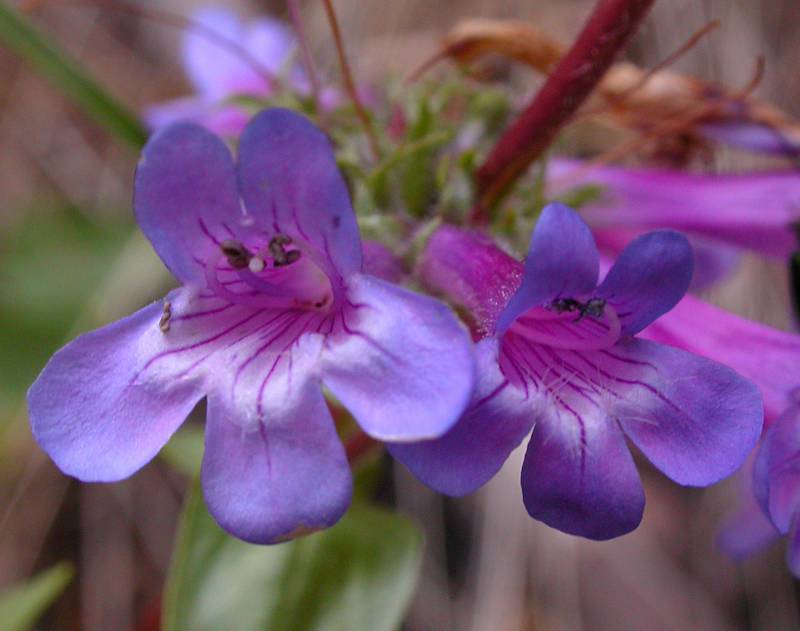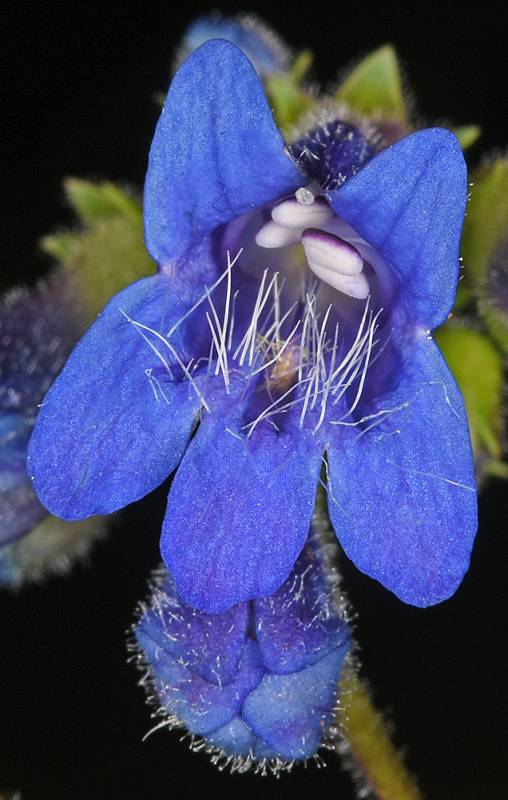|
Chelan beardtongue
|
Wilcox's beardtongue
|
| Plants tufted from a stout, branched, and woody base, the stems 1-4 dm. tall; inflorescence always glandular-hairy, the rest of the plant varying from glandular-hairy to glabrous. |
Perennial from a branched, woody base, the clustered stems 3-10 dm. tall, usually glabrous except for the inflorescence |
Leaves opposite, usually sharply serrate, sometimes most of them entire; basal leaves well-developed, up to 10 cm. long and 2 cm. wide, the blades elliptic to ovate, equaling the petiole; cauline leaves sessile, triangular-ovate to narrowly lanceolate, smaller than the basal leaves. |
Leaves opposite, strongly serrate with slender teeth, the basal leaves well-developed, elliptic to deltoid-ovate, the blade up to 9 cm. long and 5 cm. wide, about equal to the petiole; cauline leaves often larger than the basal, sessile, 4-10 cm. long and 1.5-4 cm. wide. |
Inflorescence of several compact verticillasters; calyx 3-6 mm. long, the 5 segments broadly lanceolate; corolla deep blue or lavender, 11-16 mm. long, the tube slightly expanded, 2.5-5 mm. wide at the mouth, the throat paler and marked with guide lines, glandular-hairy externally, the raised portion of the lower lip bearded; pollen sacs glabrous, dehiscent throughout and becoming opposite; staminode with a bearded tip. |
Inflorescence of several large, loose verticillasters; calyx 2.5-5 mm. long, the 5 segments broadly lanceolate, narrowly scarious-margined; corolla blue, the paler throat with guide lines, 15-23 mm. long, the tube 4-8 mm. wide at the mouth, glandular-hairy on the outside, strongly bilabiate, the lower lip much longer than the upper, the raised portion bearded; pollen sacs 0.7-1.0 mm. long, wholly dehiscent, becoming opposite, glabrous; staminode with a recurved, bearded tip. |
Capsule 5-7 mm. long, glabrous. |
Capsule 4-6 mm. long. |
|
|
|
|
| May-July |
May-July |
| Open, rocky places from the valleys and plains to moderate elevations in the mountains, and in the scablands in Washington. |
Open or often wooded, sometimes in rocky places, from the foothills to moderate elevations in the mountains. |
Occurring east of the Cascades crest in Washington; British Columbia to Washington.
|
Occurring east of the Cascades crest in eastern Washington; Washington to Oregon, east to Montana.
|
| Native |
Native |
| Not of concern |
Threatened in Washington (WANHP) |
P. acuminatus, P. attenuatus, P. barrettiae, P. cardwellii, P. cinereus, P. confertus, P. davidsonii, P. deustus, P. ellipticus, P. eriantherus, P. euglaucus, P. fruticosus, P. gairdneri, P. glandulosus, P. hesperius, P. lyallii, P. ovatus, P. palmeri, P. pennellianus, P. procerus, P. richardsonii, P. rupicola, P. rydbergii, P. serrulatus, P. speciosus, P. subserratus, P. triphyllus, P. venustus, P. washingtonensis, P. wilcoxii |
P. acuminatus, P. attenuatus, P. barrettiae, P. cardwellii, P. cinereus, P. confertus, P. davidsonii, P. deustus, P. ellipticus, P. eriantherus, P. euglaucus, P. fruticosus, P. gairdneri, P. glandulosus, P. hesperius, P. lyallii, P. ovatus, P. palmeri, P. pennellianus, P. procerus, P. pruinosus, P. richardsonii, P. rupicola, P. rydbergii, P. serrulatus, P. speciosus, P. subserratus, P. triphyllus, P. venustus, P. washingtonensis |
| |



